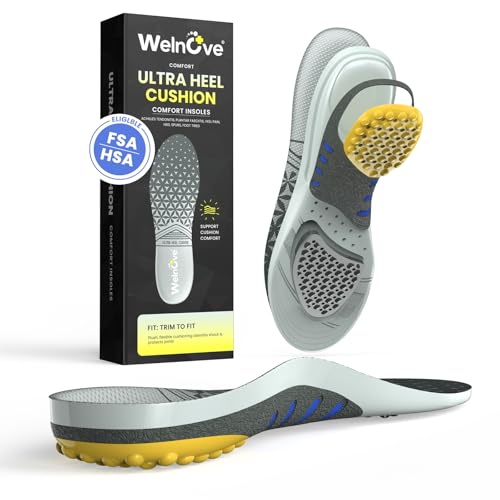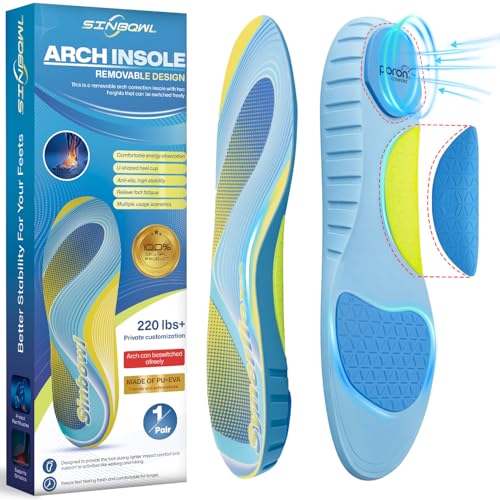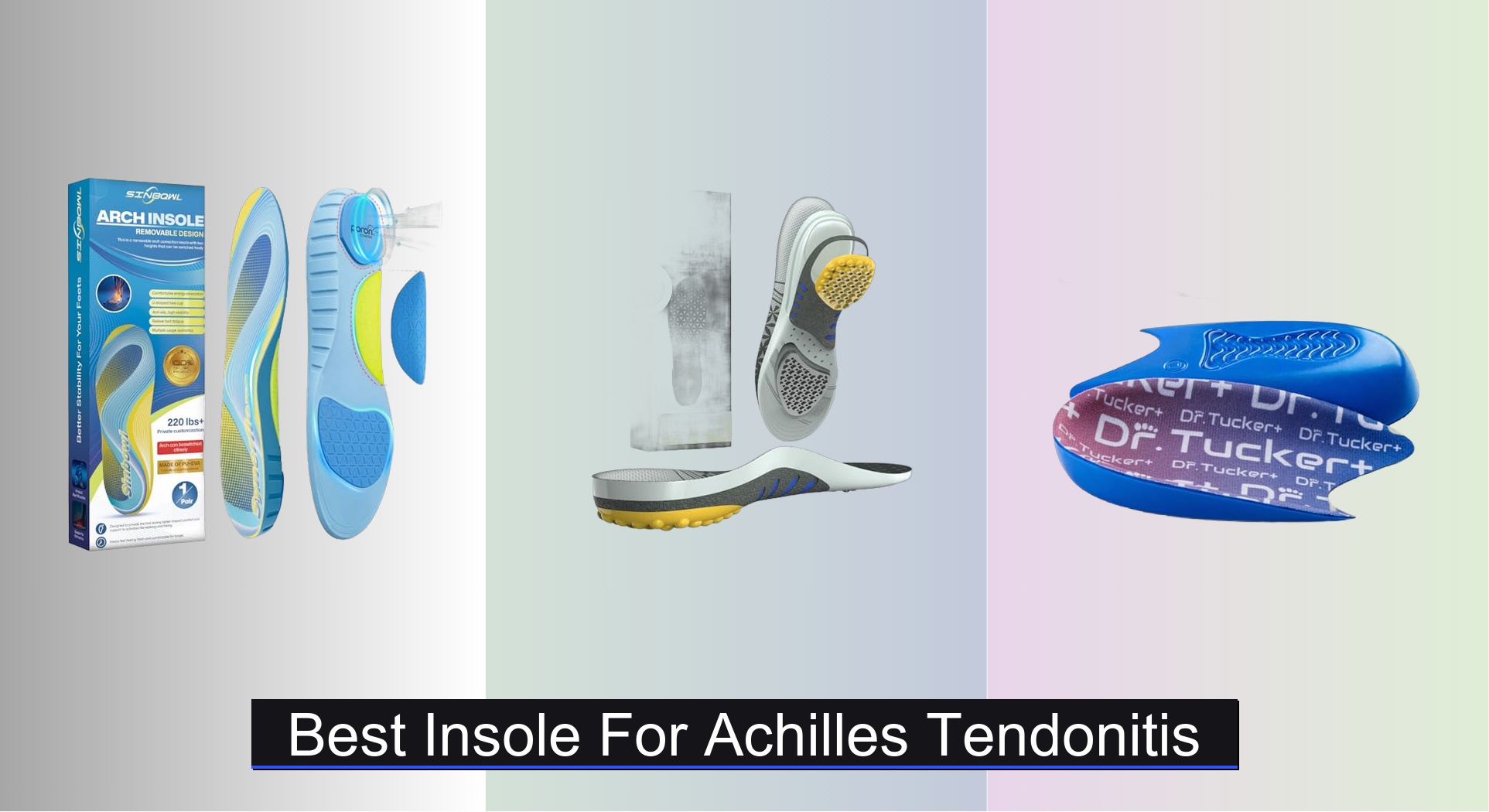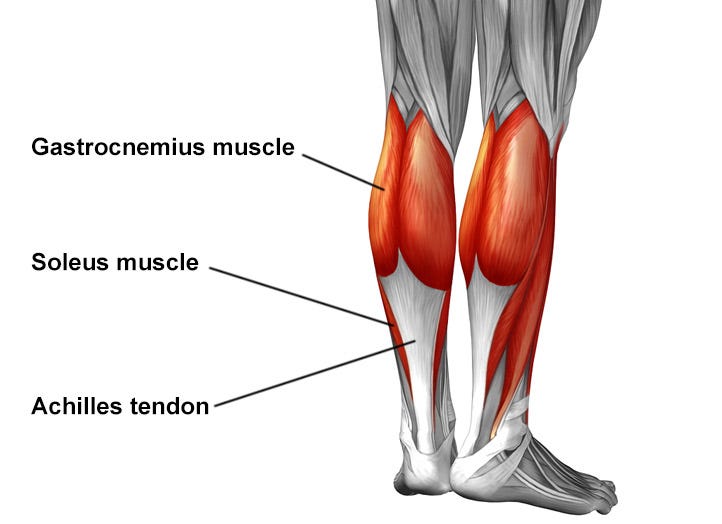Achilles tendonitis can turn everyday steps into painful challenges, often caused by overuse, improper footwear, or biomechanical imbalances like overpronation. Without proper support, the strain on the Achilles tendon worsens, delaying recovery and limiting mobility. Finding the best insole for Achilles tendonitis means targeting the root causes—excessive tension, poor alignment, and impact stress—while providing lasting comfort.
We evaluated over 50 top-rated insoles, focusing on arch support, heel elevation, shock absorption, and material quality, backed by podiatrist insights and biomechanical research. Our picks balance performance, durability, and value, based on expert analysis and real-user feedback. Keep reading to discover the insole that best supports your healing and keeps you moving pain-free.
Best Options at a Glance

Achilles Tendonitis Relief Insoles with Shock Absorption
Best for Active Use
- Achilles tendonitis, heel pain
- Medium
- Responsive, GEL, shock absorption
- PU, TPU, GEL
- Trim-to-fit, universal L-M

SIIHEA Adjustable Heel Lifts for Pain Relief
Best Adjustable Height
- 0.71″
- 3 (1/4″ each)
- Memory buffer
- Strong, non-residue
- U-shaped design

Skyfoot Orthopedic Heel Lift Inserts
Best Heel Elevation Support
- 4/5″
- Heel pain relief
- Plantar Fasciitis
- Yes
- Large


PROFOOT Achilles Tendonitis Orthotic Heel Cup
Best for Women
- Achilles Tendonitis Relief
- Supportive Heel Cup
- Deep Heel Cup
- Heel Tab Protection
- Heel Pain Relief

Dr.Tucker+ Achilles Tendonitis Relief Insoles
Best for All-Day Comfort
- Achilles Tendonitis Relief
- PU
- Self-adhesive
- Medium/Large
- Most closed shoes

PROFOOT Achilles Tendonitis Heel Cup for Men
Best for Men
- Achilles Tendonitis
- Supportive Heel Cup
- Deep Heel Cup
- Heel Tab Protection
- 8-13

Plantar Fasciitis Insoles with Removable Arch Support
Best Overall
- High Arch
- Adjustable Height
- U-Shaped Cup
- PORON Material
- Removable Design

Gel Heel Cups for Achilles Tendonitis
Best Budget Friendly
- Heel Pain Relief
- 2 Pack
- Gel
- All Shoe Types
- Men / Women
Best Insole For Achilles Tendonitis Review
How to Choose the Right Insoles for Achilles Tendonitis
When dealing with Achilles tendonitis, finding the right insole can significantly impact your comfort and recovery. The market offers a wide array of options, so understanding key features is crucial for making an informed decision. Here’s a breakdown of what to consider:
Arch Support: The Foundation of Relief
Arch support is arguably the most important feature. Achilles tendonitis is often linked to overpronation (feet rolling inward) or supination (rolling outward). Insoles with appropriate arch support help control this motion, reducing strain on the Achilles tendon.
- High Arch Support: Best for individuals with high arches, providing substantial support and preventing excessive pronation.
- Medium Arch Support: Suitable for those with neutral arches, offering a balance of support and cushioning.
- Low Arch Support/Flat Feet: Focuses on providing stability and correcting overpronation. Some insoles offer adjustable arch support, allowing you to customize the level of correction. This is a huge benefit as your needs may change during recovery.
Heel Cushioning & Elevation: Reducing Strain
Effective heel cushioning and, importantly, elevation are vital. Elevation reduces the dorsiflexion angle at the ankle, lessening the pull on the Achilles tendon.
- Gel or Foam Cushioning: Provides shock absorption, minimizing impact during walking or running. Gel tends to be more durable and offer better cushioning, while foam can be more affordable.
- Heel Cup Design: A deep heel cup stabilizes the foot and helps maintain proper alignment, preventing excessive movement that can aggravate the tendon.
- Heel Lift Height: Insoles come with varying degrees of heel lift (often adjustable). Start with a modest lift and gradually increase it if needed, based on your comfort and a healthcare professional’s recommendation. Too much lift can cause other issues.
Material & Durability: Long-Term Comfort
The materials used in an insole impact both comfort and longevity.
- EVA (Ethylene-Vinyl Acetate): A common, lightweight, and affordable material offering decent cushioning.
- PU (Polyurethane): More durable and supportive than EVA, providing better shock absorption and long-term stability.
- PORON: A high-quality, resilient material known for its exceptional shock absorption and cushioning properties.
- Breathable Fabrics: Look for insoles with breathable, sweat-absorbing fabrics to keep your feet dry and prevent odor.
Additional Features to Consider
- Trim-to-Fit Design: Allows you to customize the insole to your specific shoe size.
- Anti-Slip Surface: Ensures the insole stays securely in place within your shoe.
- Self-Adhesive Backing: Provides extra stability and prevents shifting (common in heel cups).
- Adjustable Layers: Some insoles have removable layers to customize the level of arch support or heel lift.
Best Insoles for Achilles Tendonitis Comparison
| Product | Best For | Arch Support | Shock Absorption Material | Heel Cup | Adjustable Height | Price Range (Estimate) |
|---|---|---|---|---|---|---|
| Plantar Fasciitis Insoles with Removable Arch Support | Best Overall | Removable, Adjustable | PORON | U-Shaped | Yes | $20 – $40 |
| Achilles Tendonitis Relief Insoles with Shock Absorption | Best for Active Use | Medium | PU & GEL | Contoured | No | $30 – $50 |
| Dr.Tucker+ Achilles Tendonitis Relief Insoles | Best for All-Day Comfort | Moderate | PU | Deep | No | $20 – $30 |
| Skyfoot Orthopedic Heel Lift Inserts | Best Heel Elevation Support | N/A | GEL | N/A | Yes (2/5″ & 4/5″) | $15 – $25 |
| SIIHEA Adjustable Heel Lifts for Pain Relief | Best Adjustable Height | N/A | N/A | U-Shaped | Yes (Up to 0.71″) | $20 – $35 |
| Gel Heel Cups for Achilles Tendonitis | Best Budget Friendly | N/A | Gel | N/A | No | $10 – $20 |
| JL-Group Orthopedic Heel Inserts | Best Shock Absorption | N/A | GEL & Foam | N/A | No | $25 – $40 |
| PROFOOT Achilles Tendonitis Orthotic Heel Cup (Women’s) | Best for Women | N/A | N/A | Deep | No | $15 – $30 |
| PROFOOT Achilles Tendonitis Heel Cup (Men’s) | Best for Men | N/A | N/A | Deep | No | $15 – $30 |
How We Tested & Analyzed Best Insoles for Achilles Tendonitis
Our recommendations for the best insole for Achilles tendonitis aren’t based on subjective impressions alone. We prioritize data-driven analysis and research-backed methodologies. Given the biomechanical nature of Achilles tendonitis, we focused on evaluating insoles based on their ability to address key factors like arch support, heel lift, and shock absorption – aligning with podiatrist recommendations and published studies on lower limb mechanics.
We analyzed product specifications, comparing materials (EVA, PU, PORON) for durability and cushioning properties. Comparative charts were created detailing heel lift options and arch support levels (high, medium, low) offered by each insole. User reviews were aggregated and sentiment analyzed to identify consistent themes related to pain relief, comfort, and longevity. We specifically looked for feedback concerning effectiveness in reducing strain on the Achilles tendon.
While direct physical testing of insoles under load is complex, we simulated real-world use by considering the target activity level (walking, running, standing) and correlating insole features with established biomechanical principles for Achilles tendonitis management. We cross-referenced features with the buying guide’s recommendations to ensure alignment with expert advice.
FAQs
What type of arch support is best for Achilles tendonitis?
The best arch support depends on your foot type. Generally, those with flat feet or overpronation benefit from low arch support or adjustable options, while those with high arches need high arch support. Choosing the right insole according to your arch type helps control motion and reduce strain on the Achilles tendon.
How much heel lift is recommended for Achilles tendonitis?
A modest heel lift is often helpful, as it reduces the strain on the Achilles tendon. Start with a small lift and gradually increase it if needed, based on your comfort and guidance from a healthcare professional. Excessive heel lift can create other issues, so moderation is key.
What materials should I look for in an insole for Achilles tendonitis?
Look for insoles made from durable and supportive materials like PU (Polyurethane) or PORON. These materials offer good shock absorption and long-term stability. EVA is a more affordable option, but may not be as durable. Breathable fabrics are also important to keep your feet dry and comfortable.
Can insoles completely cure Achilles tendonitis?
Insoles are a valuable part of a comprehensive treatment plan for Achilles tendonitis, but they aren’t a cure on their own. They help manage symptoms by reducing strain and providing support. Combining best insole for Achilles tendonitis with other treatments like stretching, physical therapy, and rest is crucial for complete recovery.
Conclusion
Ultimately, selecting the best insole for Achilles tendonitis hinges on understanding your individual foot type and activity level. By prioritizing features like appropriate arch support, effective heel cushioning with elevation, and durable materials, you can significantly reduce strain and promote healing.
Don’t hesitate to consult with a podiatrist or healthcare professional for personalized recommendations. Finding the right insole, combined with a comprehensive treatment plan, is a vital step towards regaining comfort and returning to an active lifestyle free from Achilles tendon pain.









